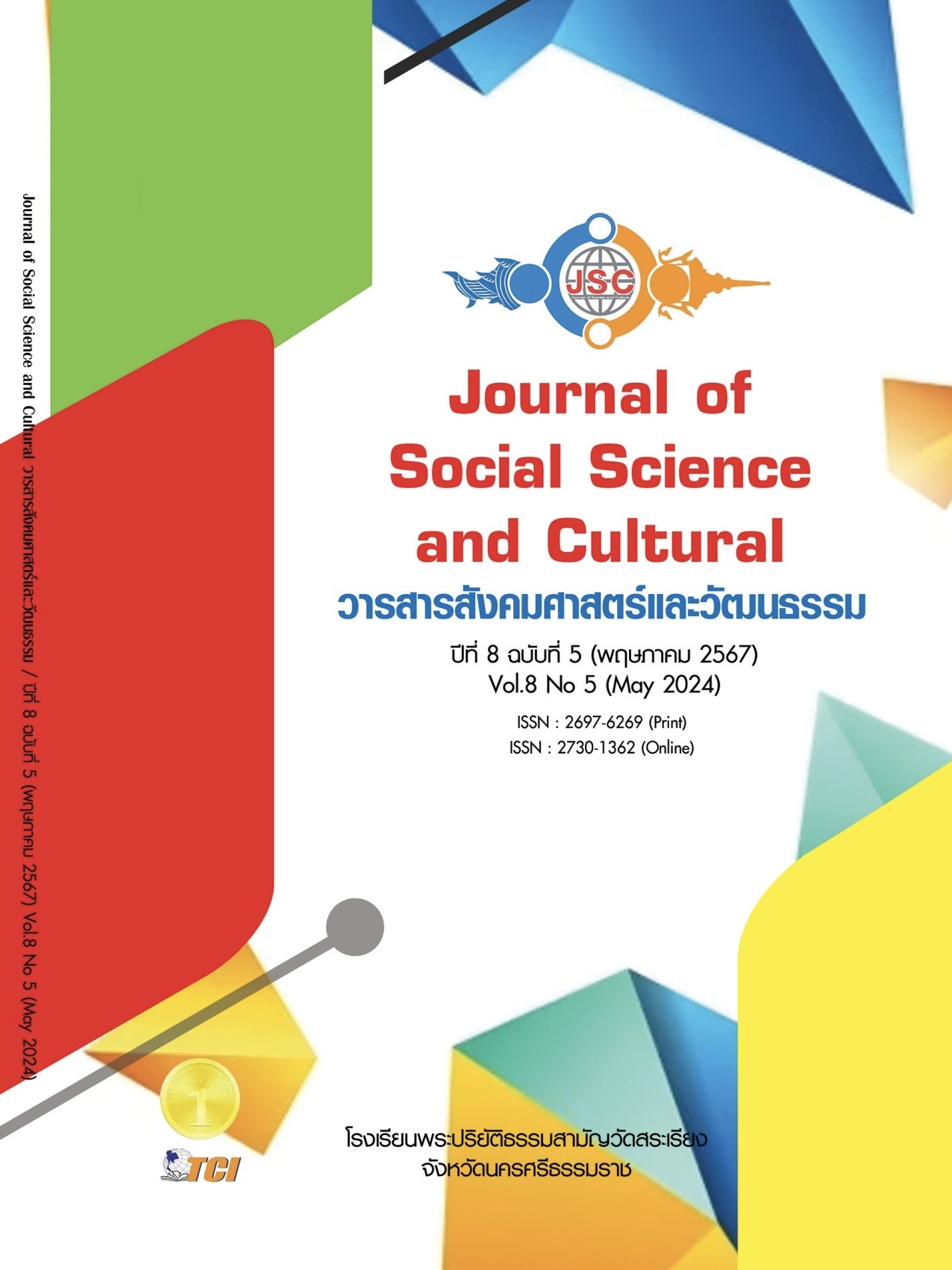การออกแบบพัฒนาแพลตฟอร์มแอปพลิเคชันไลน์สำหรับสินค้า และบริการเสริมความงามของกังนัมคลินิก
Main Article Content
บทคัดย่อ
การวิจัยเรื่องการออกแบบพัฒนาแพลตฟอร์มแอปพลิเคชั่นไลน์สำหรับสินค้าและบริการเสริมความงามของกังนัมคลินิกมีวัตถุประสงค์เพื่อ 1)ศึกษาต้นแบบแพลตฟอร์มดิจิทัล LINE Official “Gon Gang” 2)พัฒนาแพลตฟอร์มแอปพลิเคชันไลน์สำหรับสินค้าและบริการเสริมความงามกังนัมคลินิก และ 3)ศึกษาความพึงพอใจแพลตฟอร์มแอปพลิเคชันไลน์สำหรับสินค้าและบริการเสริมความงามกังนัมคลินิก โดยใช้รูปแบบการวิจัยเชิงคุณภาพและเชิงปริมาณ กลุ่มตัวอย่าง คือ ผู้ใช้บริการสินค้าและบริการเสริมความงามของกังนัมคลินิก ในพื้นที่เขตกรุงเทพมหานคร ในกลุ่ม Generation Y (อายุ 25 - 40 ปี) จำนวน 400 คน เก็บรวบรวมข้อมูลสุ่มตัวอย่างโดยไม่คำนึงถึงความน่าจะเป็นและการสุ่มตัวอย่างแบบง่ายและเก็บรวบรวมโดยใช้แบบวัดความพึงพอใจแพลตฟอร์มแอปพลิเคชั่นไลน์ ผลการวิจัยครั้งนี้พบว่า 1)แพลตฟอร์มดิจิทัล LINE Official “Gon Gang” มีองค์ประกอบที่สำคัญ สำหรับแพลตฟอร์มแอปพลิเคชันไลน์สำหรับสินค้าและบริการเสริมความงามกังนัมคลินิก 15 องค์ประกอบ 2)แพลตฟอร์มแอปพลิเคชันไลน์สำหรับสินค้าและบริการเสริมความงามกังนัมคลินิก พบว่า มีกระบวนการพัฒนาแพลตฟอร์มแอปพลิเคชันไลน์ จำนวน 5 ขั้นตอนโดยมีองค์ประกอบหลัก 2 ด้าน คือ ด้านเนื้อหา และด้านการออกแบบและการจัดรูปแบบของเว็บไซต์ และ 3) ผู้ใช้บริการมีความพึงพอใจต่อแพลตฟอร์มแอปพลิเคชันไลน์กังนัมคลินิกภาพรวมอยู่ในระดับมาก โดยมีค่าเฉลี่ย 3.83 เมื่อพิจารณาเป็นรายด้าน พบว่า ผู้ใช้บริการมีความพึงพอใจต่อแพลตฟอร์มแอปพลิเคชันไลน์กังนัมคลินิกด้านเนื้อหาอยู่ในระดับมาก โดยมีค่าเฉลี่ย 4.11 และด้านการออกแบบและการจัดรูปแบบของเว็บไซต์ พบว่า ผู้ใช้บริการมีความพึงพอใจอยู่ในระดับมาก โดยมีค่าเฉลี่ย 3.83 และพบว่าการออกแบบเว็บไซต์มีอิทธิพลต่อการรับรู้คุณภาพสินค้าและความตั้งใจซื้อทางออนไลน์
Article Details
เอกสารอ้างอิง
ไทยรัฐออนไลน์. (2564). "โลกแห่งความงาม" เปลี่ยนไป? เจาะตลาด มองเทรนด์ ภายใต้วิกฤติโควิด. เรียกใช้เมื่อ 16 กุมภาพันธ์ 2565 จาก https://www.thairath.co.th/scoop/theissue/2114796
มาริษา สุจิตวนิช และดวงใจ คงคาหลวง. (2020). แนวทางการสื่อสารการตลาดผ่านสื่อสังคมออนไลน์ในกลุ่มเจเนอเรชันเน็ต. Journal of Roi Kaensarn Academi, 5(2), 11-55.
วรลักษณ์ วงศ์โดยหวัง ศิริเจริญ. (2559). สื่อสังคม และอิทธิพลต่อการตัดสินใจซื้อของผู้บริโภค. วารสารวิชาการนวัตกรรมสื่อสารสังคม, 4(2), 152-160.
สุทธาภา อมรวิวัฒน์ และคณะ. (2557). Insight กลยุทธ์มัดใจผู้บริโภค Generation Y. เรียกใช้เมื่อ 17 กุมภาพันธ์ 2565 จาก https://www.scbeic.com/th/detail/file/product/130/dzi68owq5l/8372_20141112161337.pdf
สุรเกียรติ์ เสถียรไทย. (2561). คลินิกเสริมความงามฟื้น หลังปลดล็อก เปิดบริการได้. เรียกใช้เมื่อ 14 กุมภาพันธ์ 2565 จาก https://www.bangkokbiznews.com/health/899896
สุรีรักษ์ วงษ์ทิพย์. (2561). เครือข่ายสังคมออนไลน์: กลยุทธ์การสื่อสารการตลาดออนไลน์เพื่อดึงดูดผู้บริโภคในยุคดิจิทัล. วารสารบริหารธุรกิจเทคโนโลยีมหานคร, 15(1), 1-15.
เสาวลักษณ์ สมานพิทักษ์วงค์. (2559). ส่วนประสมทางการตลาดในการตัดสินใจซื้อสินค้าผ่านระบบอินเตอร์เน็ตของผู้บริโภคใน เขตจังหวัดสงขลา. ใน วิทยานิพนธ์บริหารธุรกิจ สาขาวิชาบริหารธุรกิจ. มหาวิทยาลัยหาดใหญ่.
อชิตพล พลเขต. (2562). แนวทางการใช้เครือข่ายสังคมออนไลน์เฟซบุ๊กในด้านการตลาดของธุรกิจคลินิกสุขภาพเพื่อความงามในอำเภอเมือง จังหวัดขอนแก่น. วารสารวิชาการบริหารธุรกิจ สมาคมสถาบันอุดมศึกษาเอกชนแห่งประเทศไทยในพระราชูปถัมภ์ สมเด็จพระเทพรัตนราชสุดาฯ สยามบรมราชกุมารี, 8(2), 169-183.
อารีวรรณ สุขวิลัย และคณะ. (2563). ความสาคัญของตัวบรรยายเรื่องกับการออกแบบ แอปพลิเคชันโมบาย. วารสารวิชาการนวัตกรรมสื่อสารสังคม, 8(1), 114-121.
Dedeke, A.N. (2016). Travel Web-Site Design: Information Task-Fit, Service Quality and Purchase Intention. Tourism Management, 54(2016), 541-554.


